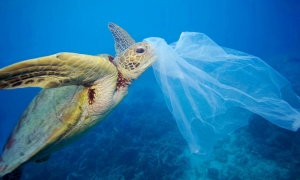What’s the Problem with Plastic?
What’s the Problem with Plastic? 
Plastics have become a ubiquitous part of life and you’ve likely heard at least some rumblings about their health hazards. You may already be on a mission to kick all species of plastic to the curb or you may be blissfully unaware of the effects of that plastic bag cradling your favorite snack. Wherever you find yourself in the conversation, THERE IS REASON TO BE CONCERNED ABOUT THE HEALTH HAZARDS OF PLASTICS. Based on the evidence thus far, PLASTICS ARE MAKING US AND OUR WORLD SICK. I hope the following will help inform and inspire you to explore ways to reduce your toxic load for the benefit of you, your family and the world we share.
BPA, perhaps the most commonly discussed chemical used in plastics, was developed in the 1890s as a synthetic estrogen and studied for its effects on the female reproductive system in rats. BPA entered the mainstream in the 1960s in the manufacture of plastic, in dental resins and in the lining of food cans. Concerns with BPA arose when studies indicated that the chemical could leach from containers into foods and beverages and was subsequently measured in human blood, urine, amniotic fluid, follicular fluid, placental tissue and umbilical cords.This finding prompted further research which has since linked BPA to a range of health problems including: Type 2 diabetes, obesity, heart disease, asthma, cancer, liver damage, ADHD, thyroid and immune dysfunction, infertility, miscarriage, endometrial disorders, polycystic ovarian syndrome (PCOS), decreased sexual function, and early onset puberty (1)
How Has BPA Been Shown to Contribute to Disease?
BPA is one of many chemicals used in plastics (phthalates are another common culprit) that are classified as endocrine disruptors. These chemicals interfere with normal endocrine (hormone) function by disrupting a hormone’s signaling pathways. More specifically, chemicals such as BPA are also known to have Estrogenic Activity (EA), mimicking or antagonizing the actions of naturally occurring estrogens 6. In healthy states, hormones, such as estrogen, act in very small amounts at precise times to regulate all of the body’s development, growth, reproduction, metabolism, immunity and behavior. BPA is known to disrupt these normal processes by binding to estrogen receptors resulting in an imbalance of hormone levels. Proper levels of estrogen in particular play a critical role in many processes from bone growth to ovulation to heart function. Alterations in these levels, particularly in utero or during early childhood, can alter brain and organ development, leading to disease later in life. In addition, the endocrine disrupting effects of BPA go beyond estrogen. BPA has also been shown to have disruptive effects on androgen and thyroid hormones and can negatively impact all three hormones even at the very low dosages most humans are exposed to on a daily basis 5. Research also indicates that continuous low dose exposure to BPA can be particularly harmful to pregnant women, the developing fetus and to infants 7. Perhaps even more disturbing is that BPA and two other plastic derived compounds (DEHP and DBP, both phthalates) have been shown to cause genetic changes that promote the inheritance of adult onset diseases such as obesity and diseases of the testes and ovaries in offspring 4.
Are “BPA – Free” Plastics Safe?
In response to concerns over the safety of BPA, the plastics industry has developed an array of “BPA- Free” plastics. But are these really any safer than BPA? A 2014 1 study put commonly found “BPA- free” objects such as baby bottles, food and beverage containers, assorted bags, “clam shells” and food wraps to the test. Shockingly researchers found that of the BPA alternatives tested, Tritan TM as well as Polystyrene (PS)  leached EA chemicals even without a heat stress such as a microwave or UV radiation. As expected, when a heat stress was applied to the same BPA – free plastics, the percentage of EA chemicals leached rose significantly. The study authors also cautioned that the although the plastic resins, glycol-modified polyethylene terephthalate (PETG), cyclic olefin polymer (COP) or copolymer (COC), did not leach EA chemicals, they should not necessarily be classified as “EA -free”. This is because various resins are not always synthesized using the same chemicals or processing methods and the smallest change in composition can cause the leaching of EA chemicals.
leached EA chemicals even without a heat stress such as a microwave or UV radiation. As expected, when a heat stress was applied to the same BPA – free plastics, the percentage of EA chemicals leached rose significantly. The study authors also cautioned that the although the plastic resins, glycol-modified polyethylene terephthalate (PETG), cyclic olefin polymer (COP) or copolymer (COC), did not leach EA chemicals, they should not necessarily be classified as “EA -free”. This is because various resins are not always synthesized using the same chemicals or processing methods and the smallest change in composition can cause the leaching of EA chemicals.
Is it possible then to find plastics that are truly “safe” and “EA- free”? Some plastic manufacturers might claim so, but due to the manufacturing differences mentioned above and the fact that many plastics are proprietary compounds, the exact composition of each plastic product and its effects on health may never be known to the consumer. Troubling.
Environmental Impacts of Plastics…Here Today, Here Tomorrow
Unlike that banana peel you just tossed, plastics never really go away. Plastic items simply break down into tiny particles, or microplastics. Not only do microplastics contain all the same harmful chemicals discussed above, they have also been shown to absorb and harbor several types of bacteria that are harmful to humans and marine life. Research conducted by the National University of Singapore found that among the 400 plus species of bacteria living on microplastic at their local beaches, three were well known species that cause gastroenteritis (Arcobacter) and wound infections (Vibrio) in humans. Among these species was also found a bacterium well known for the bleaching of coral reefs (Photobacterium rosenbergii) 2Which opens the door to a whole other topic ….
 Every year 8 million metric tons of plastic debris makes its way into our oceans and increasingly causes harm to marine critters. Varying sizes of plastic are often mistaken for food and ingested by anything from tiny shrimp to humpback whales.resulting in decreased digestive and reproductive capabilities as well as fatalities. In addition, ingested microplastics, can accumulate with each trophic level on the food chain, providing a concentrated dose of plastic toxins and bacteria for larger predators, including humans. Plastic debris, is also a well- known cause of entanglement for a variety of seabirds, turtles and seals, including some threatened species, and increasingly results in injury and death 3. And if you have trouble relating to the above, but love your beach getaways, know that a smorgasbord of micro and macroplastics can now be found strewn across even the most remote beaches in the world. How inviting.
Every year 8 million metric tons of plastic debris makes its way into our oceans and increasingly causes harm to marine critters. Varying sizes of plastic are often mistaken for food and ingested by anything from tiny shrimp to humpback whales.resulting in decreased digestive and reproductive capabilities as well as fatalities. In addition, ingested microplastics, can accumulate with each trophic level on the food chain, providing a concentrated dose of plastic toxins and bacteria for larger predators, including humans. Plastic debris, is also a well- known cause of entanglement for a variety of seabirds, turtles and seals, including some threatened species, and increasingly results in injury and death 3. And if you have trouble relating to the above, but love your beach getaways, know that a smorgasbord of micro and macroplastics can now be found strewn across even the most remote beaches in the world. How inviting.
Finally, aside from the direct effects on marine life, plastic production is energy intensive and as of late presents a significant recycling challenge. Countries like China, that previously purchased much of the world’s scrap plastic, are enacting their own single use plastic bans and will no longer accept used plastic from other countries. So as refuse plastics pile up and pollute landfills around the world, the question becomes: what to do with all this used plastic?
Summary and Recommendations
While there is need for more unbiased research regarding the safety of plastics, here’s a refresher of what we know thus far…
*Exposure to plastics with Estrogenic Activity (EA) has the ability change the structure and function of human cells and organs and has been linked to a host of diseases from diabetes to cancer to reproductive disorders.
*Plastic chemicals with EA have been shown to increase the rates of inherited adult onset diseases and are especially harmful to pregnant women, developing fetuses and infants
*Research indicates that plastic chemicals with EA produce measurable changes within the health and behavior of human populations, even at low doses.
* “BPA-free” plastics have also been shown to have significant EA even without a heat stressor
* Even if a plastic resin tested as “EA-free”, it will likely not always be so due to changes in manufacturing procedures and changes in chemical composition of plastic resins
*Many plastics are proprietary compounds and therefore their exact chemical makeup of and whether they have EA is difficult to determine
*Micro and macro plastics are significant causes of marine animal injury and mortality annually and is an increasing threat to species survival
*Used plastics present a colossal disposal and recycling challenge yet to be solved
Based on the known health and environmental impacts of plastics, WHY WAIT FOR A GOVERNING BODY TO DETERMINE FOR YOU WHAT, IF ANY, PLASTICS ARE “SAFE” WHEN YOU CAN UTILIZE BETTER OPTIONS TODAY?If you desire health for you, your family, the planet and the generations to come, THE STRONG RECOMMENDATION IS TO ERR ON THE SIDE OF CAUTION AND MINIMIZE YOUR EXPOSURE TO AND USE OF PLASTICS.You can start reducing your plastic consumption one step at a time with some of the following strategies….
Tips for Minimizing Your Plastic Exposure
Start by simply by BECOMING AWARE of how often the products you buy most frequently contain plastic. Plastics are sneaky, inhabiting just about every area of our lives. Make obtainable goals by choosing one area each week or month in which you can reduce your plastic usage. If unsure of where to begin, the following are some practical ways to engage in reducing your plastic footprint, one step at a time.
*PUT DOWN THE PLASTIC WATER BOTTLE OR CUP… AND HOLD THE STRAW! Use your own STAINLESS OR GLASS CUPS, BOTTLES OR CONTAINERS when grabbing that next coffee or water refill. If you or your kiddos can’t part with straws PURCHASE A REUSABLE STAINLESS VERSION or at minimum use paper straws. You can also minimize the need for single use plastic utensils by keeping a set of BAMBOO UTENSILS in your backpack, car or purse for easy access.
* FOR KIDDOS: Choose STAINLESS OR BAMBOO BASED BOTTLES, CUPS AND DINING WARE AS WELL AS NATURAL RUBBER PACIFIERS AND WOODEN TOYS. Remember, young ones are especially sensitive and susceptible to the negative health impacts of plastic chemicals.
* SAY NO THANK YOU TO THAT PLASTIC BAG, which on average is only used for 12 minutes! Many cities, states and countries have already outlawed the use of single use plastic bags and require that customers bring their own or pay a fee for a paper bag. Even if this is not the case in your area, get ahead of the curve and BRING YOUR OWN CLOTH BAGS. Keep a stash in your car, backpack or bike pannier for easy access.
* AVOID COOKING OR STORING FOOD IN PLASTIC CONTAINERS OR BAGS. Use alternatives such as GLASS, PORCELAIN OR STAINLESS -STEEL CONTAINERS. Remember that even without a heat stress, plastics have been known to leach disease causing chemicals into their contents.
* BUY UNWRAPPED FRESH, WHOLE, UNPROCESSED ORGANIC FOODS. Not only are these free of harmful plastics but they are also rich in nutrients and fiber necessary to aid your body’s own detoxification processes! Farmers markets provide the freshest, most nutrient dense sources of food and many markets recycle items such as berry or egg containers for future use.
*BUY FOOD ITEMS SUCH AS GRAINS, NUTS, SEEDS AND BEANS IN BULK USING YOUR OWN SMALL CLOTH BAGS for transport. Store these items in glass jars once at home to retain freshness. AVOID PURCHASING ITEMS PACKAGED IN PLASTIC OR CANS, LOOK INSTEAD FOR GLASSOR PAPER packaging.
*Plan ahead and BRING YOUR OWN LUNCH rather than purchasing plastic laden “to go” foods. Packing a lunch saves you cash and allows you time to relax or go for a walk to destress with the time you save not driving to get fast food. If you do wish to eat out, choose a “sit down” restaurant that uses reusable silverware and plates as opposed to disposable varieties.
*INSTALL A HOME WATER FILTER SYSTEM or purchase a BERKEY WATER FILTER
* Use BEESWAX FOOD WRAPS instead of plastic wraps or ziplock bags to cover cut produce, bowls of leftovers and sandwiches
* SAY NO TO THAT CASH REGISTER RECEIPT AS IT TOO CONTAINS PLASTIC! If in need of a receipt, ask if the vendor offers copies via text or email.
* CLOTHE YOURSELF IF NATURAL FIBERS SUCH AS COTTON, WOOL, HEMP AND BAMBOO. Microplastics in synthetic fibers not only have contact with your skin during wear but also are pulled out during washing cycles and released into the water supply.
* BUY HOME AND BODY CARE ITEMS IN BULK AND IN PAPER OR GLASS PACKAGING. More to come on this in next month’s blog post about cleaning up your home and personal care routine!
A Parting Word
While many of the suggestions here are simple, they take time and a reallocation of energy and resources to implement. So, as with all change, be gracious with yourself in the process, knowing that each small step will benefit your health and that of the global community today and in future generations. And don’t be surprised as you weed plastics out and opt for cleaner foods and products that you feel better. Aligning with the natural rhythms has a beautiful way of leading toward health and well-being!
References
1.Bittner, G. D., Yang, C. Z., & Stoner, M. A. (2014). Estrogenic chemicals often leach from BPA-free plastic products that are replacements for BPA-containing polycarbonate products. Environmental Health, 13(1), 41.
2. Curren, E., & Leong, S. C. Y. (2019). Profiles of bacterial assemblages from microplastics of tropical coastal environments. Science of the Total Environment, 655, 313-320.
3. Gall, S. C., & Thompson, R. C. (2015). The impact of debris on marine life. Marine pollution bulletin, 92(1-2), 170-179.
4. Manikkam, M., Tracey, R., Guerrero-Bosagna, C., & Skinner, M. K. (2013). Plastics derived endocrine disruptors (BPA, DEHP and DBP) induce epigenetic transgenerational inheritance of obesity, reproductive disease and sperm epimutations. PloS one, 8(1), e55387.
5. Rochester, J. R. (2013). Bisphenol A and human health: a review of the literature. Reproductive toxicology, 42, 132-155.
6. Vandenberg, L. N., Maffini, M. V., Sonnenschein, C., Rubin, B. S., & Soto, A. M. (2009). Bisphenol-A and the great divide: a review of controversies in the field of endocrine disruption. Endocrine reviews, 30(1), 75-95.
7. Vom Saal, F. S., VandeVoort, C. A., Taylor, J. A., Welshons, W. V., Toutain, P. L., & Hunt, P. A. (2014). Bisphenol A (BPA) pharmacokinetics with daily oral bolus or continuous exposure via silastic capsules in pregnant rhesus monkeys: Relevance for human exposures. Reproductive Toxicology, 45, 105-116.





